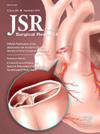开腹还是闭腹?普外科急诊腹腔手术后皮肤切口的处理。
IF 1.8
3区 医学
Q2 SURGERY
引用次数: 0
摘要
简介:我们试图确定急诊普外科(EGS)开腹手术患者的皮肤管理与手术部位感染(SSI)之间是否存在关系。我们假设皮肤闭合技术与 SSI 无关:我们对 2015 年至 2019 年期间因 EGS 病症在手术会诊后 6 小时内接受探查性开腹手术的成年患者(大于 18 岁)进行了回顾性研究。排除了在索引手术中筋膜未闭合的患者。患者分为两组:开放皮肤组(OS)和封闭皮肤组(CS)。OS包括负压伤口治疗或湿到干的纱布;CS包括用订书机或缝线缝合。我们的主要结果是 SSI 发生率:结果:组群包括 388 名患者:42.3%为OS组(164人),57.7%为CS组(224人)。OS组的全身炎症反应综合征[SIRS]发生率更高(54.9%对27.7%,P 结论:OS组的全身炎症反应综合征[SIRS]发生率更高:在 EGS 开腹手术后出现 SIRS、HVP 和伤口脏污的患者中,OS 处理更为常见。然而,我们发现不同组间的 SSI 并无差异,这表明对于污染或不洁伤口可考虑进行皮肤缝合。本文章由计算机程序翻译,如有差异,请以英文原文为准。
Open or Closed? Management of Skin Incisions After Emergency General Surgery Laparotomies
Introduction
We sought to determine if there was a relationship between skin management and surgical site infections (SSIs) among patients undergoing a laparotomy for emergency general surgery (EGS). We hypothesize that skin closure technique is not associated with SSI.
Methods
We performed a retrospective review of adult patients (>18 y) who underwent an exploratory laparotomy for EGS conditions within 6 h of surgical consultation from 2015 to 2019. Patients whose fascia was not closed during the index operation were excluded. Patients were divided into groups: open skin (OS) and closed skin (CS). OS included negative pressure wound therapy or wet-to-dry gauze; CS included closure with staples or sutures. Our primary outcome was the rate of SSI.
Results
The cohort comprised 388 patients: 42.3% OS (n = 164) and 57.7% CS (n = 224). The OS group had greater rates of systemic inflammatory response syndrome [SIRS] (54.9% versus 27.7%, P < 0.0001), hollow viscus perforation [HVP] (71.3% versus 20.5%, P < 0.0001), and peritoneal drains (51.2% versus 17.9%, P < 0.0001). Rates of OS management increased as wound class severity increased (0% [I] versus 12.2% [II] versus 15.9% [III] versus 72% [IV], P < 0.0001). The SSI rate for the cohort was 3.6% (n = 14); there was no difference in SSI rates (2.7% versus 4.9%, P = 0.3) between the CS or OS groups. Median length of stay was longer for the OS group (10 d versus 6.5 d, P < 0.0001). Independent predictors of OS management were SIRS (adjusted odds ratio [aOR] 1.72, 95% confidence interval [CI] 1.01-2.93, P = 0.04), HVP (aOR 2.03, 95% CI 1.09-3.8, P = 0.03), and class III/IV wounds (aOR 8.65, 95% CI 4.43-16.89, P < 0.0001).
Conclusions
OS management occurs more often in patients with SIRS, HVP, and dirty wounds after EGS laparotomies. However, we found no difference in SSI between groups, suggesting that skin closure can be considered in contaminated or dirty wounds.
求助全文
通过发布文献求助,成功后即可免费获取论文全文。
去求助
来源期刊
CiteScore
3.90
自引率
4.50%
发文量
627
审稿时长
138 days
期刊介绍:
The Journal of Surgical Research: Clinical and Laboratory Investigation publishes original articles concerned with clinical and laboratory investigations relevant to surgical practice and teaching. The journal emphasizes reports of clinical investigations or fundamental research bearing directly on surgical management that will be of general interest to a broad range of surgeons and surgical researchers. The articles presented need not have been the products of surgeons or of surgical laboratories.
The Journal of Surgical Research also features review articles and special articles relating to educational, research, or social issues of interest to the academic surgical community.

 求助内容:
求助内容: 应助结果提醒方式:
应助结果提醒方式:


